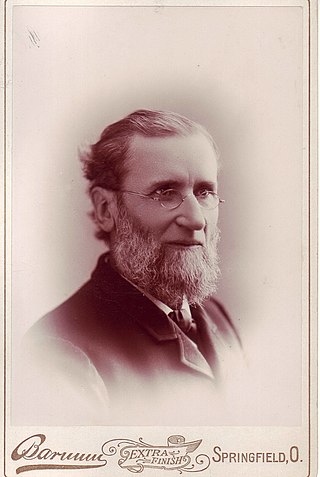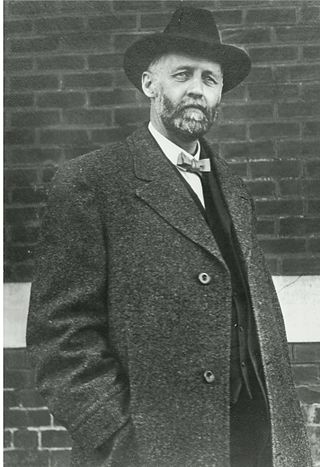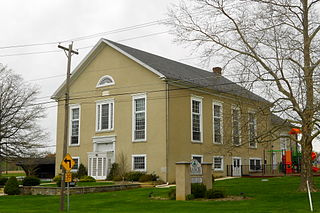
Newville is a borough in Cumberland County, Pennsylvania, United States. The borough is located west of Carlisle. The population was 1,376 at the 2020 census. It is part of the Harrisburg–Carlisle metropolitan statistical area.

Chambersburg is a borough in and the county seat of Franklin County, in the South Central region of Pennsylvania, United States. It is in the Cumberland Valley, which is part of the Great Appalachian Valley, and 13 miles (21 km) north of Maryland and the Mason-Dixon line and 52 miles (84 km) southwest of Harrisburg, the state capital. According to the United States Census Bureau, Chambersburg's 2020 population was 21,903. When combined with the surrounding Greene, Hamilton, and Guilford Townships, the population of Greater Chambersburg is 52,273 people. The Chambersburg, PA Metropolitan Statistical Area includes surrounding Franklin County, and in 2010 included 149,618 people.

Muncy is a borough in Lycoming County, Pennsylvania. The name Muncy comes from the Munsee Indians who once lived in the area. The population was 2,442 at the 2020 census. It is part of the Williamsport, Pennsylvania Metropolitan Statistical Area. Muncy is located on the West Branch Susquehanna River, just south of the confluence of Muncy Creek with the river. Currently the borough president is Bill Scott and the mayor is Jon Ort.

The Cumberland Presbyterian Church is a Presbyterian denomination spawned by the Second Great Awakening. In 2019, it had 65,087 members and 673 congregations, of which 51 were located outside of the United States. The word Cumberland comes from the Cumberland River valley where the church was founded.
Scotch-IrishAmericans are American descendants of Ulster Scots people who emigrated from Ulster to America during the 18th and 19th centuries. Their ancestors had originally migrated to Ulster mainly from the Scottish Lowlands and Northern England in the 17th century. In the 2017 American Community Survey, 5.39 million reported Scottish ancestry, an additional 3 million identified more specifically with Scotch-Irish ancestry, and many people who claim "American ancestry" may actually be of Scotch-Irish ancestry.

Cumberland County is a county in the Commonwealth of Pennsylvania. As of the 2020 census, the population was 259,469. Its county seat is Carlisle.
The Great Wagon Road was an improved trail through the Great Appalachian Valley from Pennsylvania to North Carolina, and from there to Georgia in colonial America.

Samuel Finley was an Irish-born American Presbyterian minister and academic. He founded the West Nottingham Academy and was the fifth president and an original trustee of the College of New Jersey from 1761 until 1766.

The Old Scotch Church, also known as the Tualatin Plains Presbyterian Church, is a church and national historic site located in an unincorporated part of Washington County, Oregon, near Hillsboro, Oregon, United States. The church dates to 1873 while the church structure with an eight-sided steeple dates to 1878. A cemetery on the church grounds holds the graves of church members and local pioneer settlers of the Tualatin Plains, including Joseph Meek.

Colonel Denning State Park is a 273-acre (110 ha) Pennsylvania state park in Lower Mifflin Township, Cumberland County, Pennsylvania in the United States. The park is in the Doubling Gap of Blue Mountain on Pennsylvania Route 233 between Newville and Landisburg. Doubling Gap Lake is a man-made lake covering 3.5 acres (1.4 ha). Colonel Denning State Park is surrounded by Tuscarora State Forest.

Captain Samuel Brady (1756–1795) was an Irish American Revolutionary War officer, frontier scout, notorious Indian fighter, and the subject of many legends, in the history of western Pennsylvania and northeastern Ohio. He is best known for reportedly jumping across a gorge over the Cuyahoga River to escape pursuing Indians in what is present day Kent, Ohio. This jump is still remembered as "Brady's leap".

Hugh Brady was an American general from Pennsylvania. He served in the Northwest Indian War under General Anthony Wayne, and during the War of 1812. Following the War of 1812, Brady remained in the military, eventually rising to the rank of major general and taking command of the garrison at Detroit. He also marginally participated in the 1832 Black Hawk War. Hugh Brady died an accidental death in 1851 when he was thrown from a horse-drawn carriage.

Luther Alexander Gotwald, D.D. was a professor of theology in the Wittenberg Theological Seminary in the United States. He was tried for heresy by the board of directors at Wittenberg College in Springfield, Ohio, on April 4 and 5, 1893, which put on trial many key issues that Lutherans still debate today.

David Ward King was an American farmer and inventor of the King road drag. His invention, which was the horse-drawn forerunner of the modern road grader, had a great influence on American life because his invention improved the widespread dirt roads of his day to the extent that they could accommodate the advent of the automobile, rural mail delivery and mail order catalogues.

The Frankstown Path, was the highway for earlier travelers and fur traders in central Pennsylvania. It passed through Harts Log along the Juniata River. The place was first named after a hollow log at the site, which the trader John Hart used between 1744 and 1755 as a feeding trough for his pack horses.

The Newville Historic District is a national historic district which is located in Newville, Cumberland County, Pennsylvania. The district is bordered roughly by Cove Alley, Big Spring Creek, the right-of-way for the Cumberland Valley Railroad, and Washington Street, and encompasses 414 contributing buildings, one contributing site, and two contributing objects in the central business district and surrounding residential areas of Newville.

The Old Scots Burying Ground is a historic cemetery located on Gordon's Corner Road in the Wickatunk section of Marlboro Township, in Monmouth County, New Jersey. It was added to the National Register of Historic Places on August 15, 2001, for its significance in history and religion. The Old Scots Burying Ground is about an acre in size, about 195 feet above sea level and dates back to 1685. The total number of burials at the cemetery is not precisely known, suggested by Symms, "There are a large number of graves in Old Scots yard without any inscribed stones". Some reports place the number as at least 100 known graves with most headstones of brown sandstone. However, more recent research using ground penetrating radar reported by the Old Tennent Church in 2001 has put the number of confirmed sites at about 122 graves with a possible 140 more unmarked; placing the number at about 262 total graves in the cemetery. In 1945, in an attempt to clean out the site of vegetation and over-growth, a bulldozer was used on the property and as a result some headstones were dislodged and broken stones removed. The defining structure in the cemetery is a tall monument to Rev. John Boyd, created by the J&R Lamb Company. Built to commemorate the first recorded Presbyterian ordination of Rev. John Boyd. The monument is currently owned by the Synod of the Northeast who holds the property deed but it is maintained by the Old Tennent Church. The last identified burial was in 1977.

John Blair was a Presbyterian minister, a Trustee, Professor, and Acting President of Princeton University. His brother Samuel Blair was a leader of the Presbyterian New Light religious movement. His nephew, Samuel Blair was the second Chaplain of the United States House of Representatives.
Rev. John E. Price was an elder and minister of the African Methodist Episcopal Zion Church. He was a minister for around 50 years. He was the founder and president of the Garnet Equal Rights League at Harrisburg. He wrote hymns and was an editor for the Zion Church Advocate and, with William H. Day, the Zion Church Herald and Outlook, the first paper of the AME Zion Church. Day was a minister, abolitionist, and educator.
Henry Thomas Thurber was an American attorney.





















